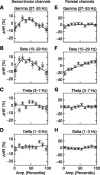Prestimulus oscillations enhance psychophysical performance in humans
- PMID: 15537890
- PMCID: PMC6730198
- DOI: 10.1523/JNEUROSCI.2584-04.2004
Prestimulus oscillations enhance psychophysical performance in humans
Abstract
The presence of various ongoing oscillations in the brain is correlated with behavioral states such as restful wakefulness or drowsiness. However, even when subjects aim to maintain a high level of vigilance, ongoing oscillations exhibit large amplitude variability on time scales of hundreds of milliseconds to seconds, suggesting that the functional state of local cortical networks is continuously changing. How this volatility of ongoing oscillations influences the perception of sensory stimuli has remained essentially unknown. We investigated the relationship between prestimulus neuronal oscillations and the subjects' ability to consciously perceive and react to somatosensory stimuli near the threshold of detection. We show that, for prestimulus oscillations at approximately 10, 20, and 40 Hz detected over the sensorimotor cortex, intermediate amplitudes were associated with the highest probability of conscious detection and the shortest reaction times. In contrast, for 10 and 20 Hz prestimulus oscillations detected over the parietal region, the largest amplitudes were associated with the best performance. Our data indicate that the prestimulus oscillatory activity detected over sensorimotor and parietal cortices has a profound effect on the processing of weak stimuli. Furthermore, the results suggest that ongoing oscillations in sensory cortices may optimize the processing of sensory stimuli with the same mechanism as noise sources in intrinsic stochastic resonance.
Figures



References
-
- Arieli A, Sterkin A, Grinvald A, Aertsen A (1996) Dynamics of ongoing activity: explanation of the large variability in evoked cortical responses. Science 273: 1868-1871. - PubMed
-
- Chialvo DR, Apkarian AV (1993) Modulated noisy biological dynamics: three examples. J Stat Phys 70: 375-391.
-
- Collins JJ, Imhoff TT, Grigg P (1996) Noise-enhanced tactile sensation. Nature 383: 770. - PubMed
-
- Engel AK, Fries P, Singer W (2001) Dynamic predictions: oscillations and synchrony in top-down processing. Nat Rev Neurosci 2: 704-716. - PubMed
Publication types
MeSH terms
LinkOut - more resources
Full Text Sources
